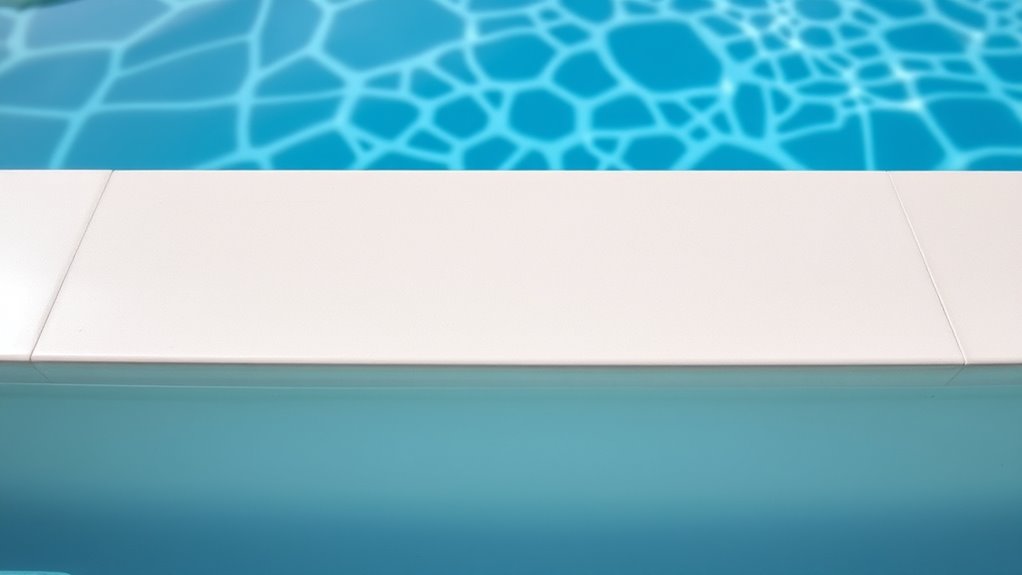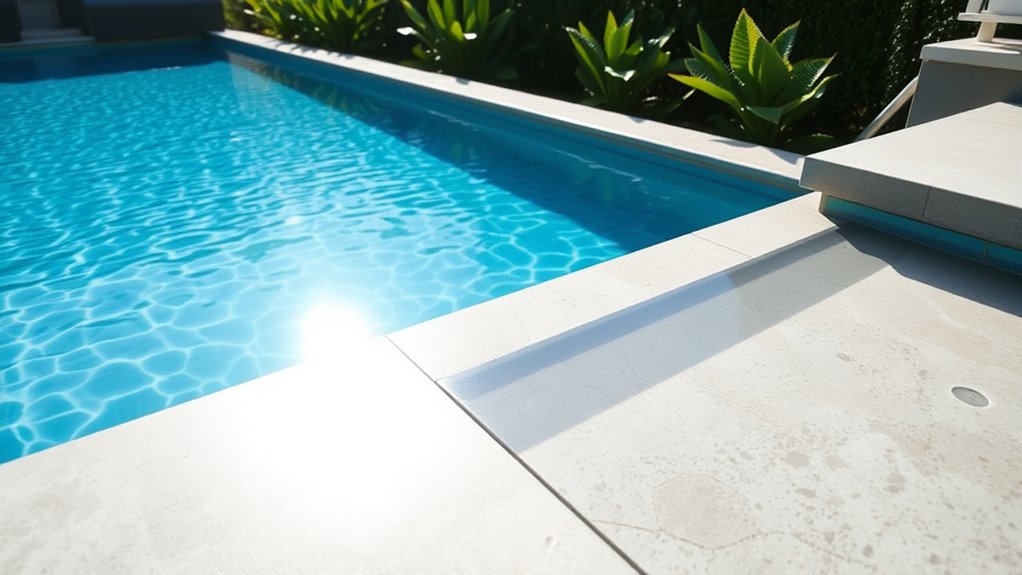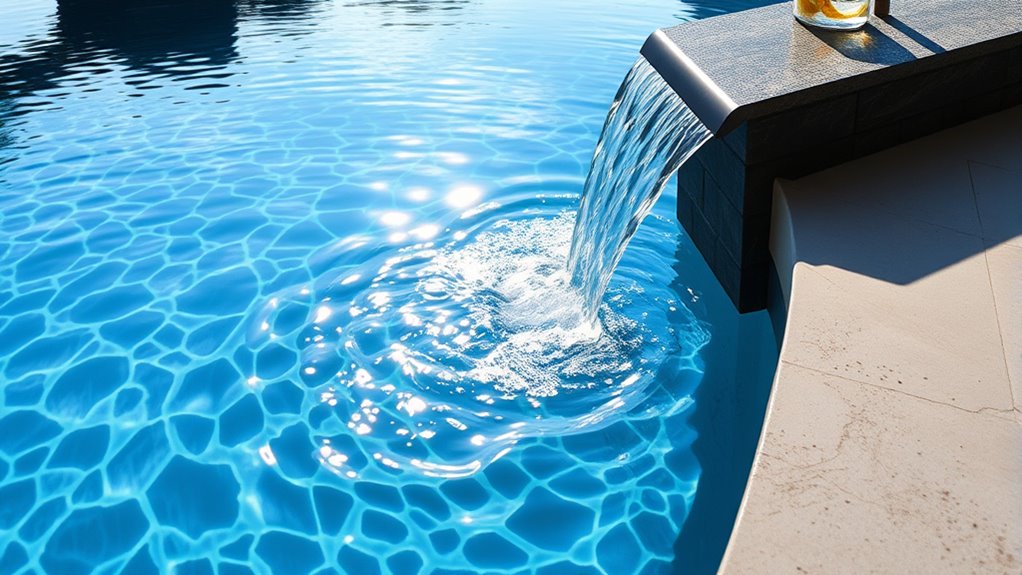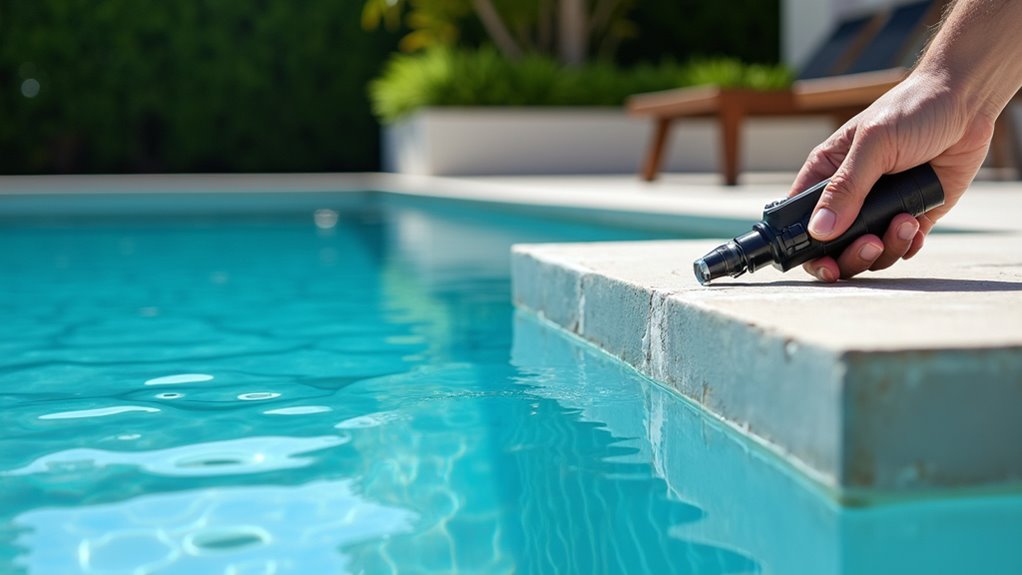Start by regularly checking your pool’s water level against a fixed point to spot drops beyond normal evaporation. Inspect the skimmer, main drain, spillway, and fittings for cracks, leaks, or corrosion. Examine the overflow and perimeter drainage for blockages or damage. Look around the deck for wet spots or mineral deposits. Testing with dye and monitoring water levels over time help identify hidden leaks. Keep exploring to learn more about pinpointing issues effectively.
Key Takeaways
- Start with water level monitoring and visual inspection for sudden drops or signs of cracks, settling, or damp areas.
- Check pool fittings, seals, and plumbing connections for leaks, corrosion, or deterioration.
- Inspect the spillway, overflow, and drainage systems for blockages, cracks, or damage.
- Use dye tests and water level tracking to identify hidden leaks and confirm persistent water loss.
- Focus on connection points, fittings, joints, and areas around lighting fixtures for signs of seepage or pooling.
Inspect the Pool’s Water Level Regularly

Regularly checking the pool’s water level is one of the simplest yet most effective ways to detect leaks in a vanishing-edge pool. Sudden drops in water level, beyond normal water evaporation, indicate possible water displacement caused by a leak. You should monitor the water level daily, especially during periods of low evaporation, to identify unusual decreases. Keep a consistent reference point, like a marked line on the pool’s edge, to measure changes accurately. If you notice the water level dropping faster than evaporation rates, it’s a sign that water might be escaping through a leak. Early detection through regular checks helps prevent damage and costly repairs, ensuring your pool remains in ideal condition. Additionally, understanding water evaporation rates can help you better distinguish between normal water loss and leaks.
Examine the Skimmer and Main Drain Fittings

To detect leaks effectively, you should carefully examine the skimmer and main drain fittings for any signs of damage or leaks. Look closely at the skimmer gasket; a worn or cracked gasket can cause water loss. For the main drain, check the main drain seal for cracks or deterioration, which can also lead to leaks. Tighten loose fittings and replace damaged components promptly. Use the table below to guide your inspection:
| Component | Common Issue | Solution |
|---|---|---|
| Skimmer Gasket | Cracks or wear | Replace gasket |
| Main Drain Seal | Cracks or looseness | Replace seal or tighten |
| Fittings | Leaks or corrosion | Tighten fittings or replace |
Regular inspection guarantees you catch leaks early and maintain your pool’s integrity. Additionally, understanding the importance of proper installation techniques can prevent many common leak issues before they arise.
Check the Overflow and Perimeter Drainage Systems

Start your inspection of the overflow and perimeter drainage systems by visually checking for blockages, leaks, or damage. During overflow inspection, look for debris or obstructions that could hinder water flow, causing potential leaks or overflow issues. Guarantee the overflow grate is secure and intact. For perimeter drainage, examine the drainage channels and pipes around the pool’s edge for cracks, leaks, or blockages. Clear any debris that might clog the system and verify that water drains properly through these channels. Proper functioning of the overflow and perimeter drainage systems is essential for maintaining the pool’s water level and preventing leaks. Regular maintenance and understanding drainage system components can help identify issues early and prevent costly repairs. Address any issues immediately to avoid further damage and ensure accurate leak detection.
Look for Signs Around the Pool Deck and Surroundings

Check around the pool deck and nearby areas for any cracks or settling that might suggest shifting. Look for wet or soft spots on the ground, which could indicate leaks or pooling. Keep an eye on water level fluctuations, as consistent drops are often a sign of a hidden leak. Additionally, consider the presence of security lighting or surveillance cameras nearby, which can help monitor unusual activity or water loss around the pool area.
Cracks or Settling
Cracks or settling around the pool deck and its surroundings can be clear indicators of underlying issues, such as leaks or structural shifts. These signs often point to foundation movement or shifting that compromises stability. You should look for:
- Visible cracks in the concrete or surrounding walls, especially near the pool edge.
- Uneven or sinking areas in the deck, indicating potential settlement.
- Gaps or separation between the pool structure and the deck or nearby structures.
Structural shifts caused by foundation movement can lead to cracks or uneven settling, signaling possible leaks or ongoing damage. Addressing these early helps prevent more severe problems and costly repairs. Keep an eye on any signs of movement to maintain your pool’s integrity. Additionally, monitoring the horsepower and overall structural health of your pool area can help in early detection of issues.
Wet or Soft Areas
Wet or soft areas around the pool deck can be telltale signs of leaks or drainage issues. If you notice the ground appearing uneven or sinking, ground settling might be causing the surface to shift and create soft spots. Additionally, vegetation intrusion near the pool can signal excess moisture, fostering plant growth where it shouldn’t be. These soft patches may feel spongy or unstable underfoot, indicating water seeping into the ground beneath. Keep an eye out for pooling water or muddy areas that persist despite dry weather. Such signs suggest that water is escaping from the pool system, possibly due to a leak. Addressing these issues early can prevent further ground shifting and damage to your pool’s structure. Recognizing vetted pool maintenance practices can help you identify and fix issues before they worsen.
Water Level Fluctuations
Unusual water level fluctuations in your pool can be a clear indicator of hidden leaks. If you notice the water level dropping consistently without heavy usage, it might be due to a leak rather than evaporation loss. Keep an eye on signs around the pool deck and surroundings, such as water pooling or damp spots. To assess if evaporation is the cause, consider these points:
- Measure water loss over several days during dry, hot weather when water evaporation is high.
- Check for consistent water level drops that exceed typical evaporation rates.
- Observe if the water level stabilizes after rain or adding water, indicating a leak rather than evaporation loss.
Persistent fluctuations suggest you should investigate further for potential leaks.
Test for Leaks in the Vanishing Edge Spillway

To test for leaks in the vanishing edge spillway, start with a visual inspection to identify any cracks or irregularities. You can also use a dye test to see if dye escapes through unseen leaks, and monitoring water levels over time helps confirm persistent loss. Combining these methods guarantees you accurately detect and address any issues with the spillway.
Visual Spillway Inspection
Conducting a visual spillway inspection is a straightforward way to identify leaks in a vanishing-edge pool. Start by examining the spillway design for any visible cracks, warping, or misalignment that could cause leaks. Next, inspect the spillway material for signs of deterioration, such as erosion, discoloration, or cracks. Finally, observe the water flow:
- Look for inconsistent or reduced water flow over the spillway.
- Check for pooling or wet spots around the spillway edges.
- Watch for water escaping from joints or seams that shouldn’t leak.
These signs can indicate issues with the spillway’s integrity. Regular visual inspections help catch problems early, especially in relation to the spillway’s design and material, ensuring your pool remains leak-free. Additionally, paying attention to good lighting can help reveal subtle leaks or damage that might otherwise go unnoticed.
Dye Test Method
A dye test provides a targeted way to confirm leaks that might not be visible during a visual inspection. You start by adding a small amount of color changing dye into the pool’s spillway or surrounding area. The dye test procedure involves carefully observing how the dye disperses and whether it enters any cracks, joints, or leaks in the spillway. If there’s a leak, the dye will quickly seep into the problem area, revealing its location. This method is especially useful for pinpointing hidden leaks that aren’t apparent through visual cues alone. Using a dye test is a reliable, straightforward way to identify the source of a leak, allowing you to focus your repair efforts precisely where they’re needed. Leak detection techniques are essential for maintaining the integrity of vanishing-edge pools.
Monitoring Water Levels
Monitoring water levels over time is a straightforward way to detect leaks in the vanishing-edge spillway. You’ll want to observe how the water changes daily, especially under consistent conditions. Sudden drops may indicate leaks rather than evaporative loss or splash out. To better pinpoint issues, consider these steps:
- Record water levels daily at the same time to identify irregular declines.
- Compare water loss during rainy days versus dry days to rule out evaporative loss.
- Mark water levels with a waterproof marker to detect even small drops that could signal a leak.
- Understanding water evaporation rates can help differentiate between normal water loss and leaks, ensuring accurate diagnosis.
If water levels drop faster than expected from splash out or evaporation, it’s likely you have a leak needing further inspection. Regular monitoring helps catch problems early before costly repairs.
Assess Pool Equipment and Plumbing Connections

To effectively identify leaks in a vanishing-edge pool, start by thoroughly inspecting the pool equipment and plumbing connections. Check the pump, filter, and heater for signs of leaks, corrosion, or loose fittings. Confirm all valves are secure and functioning properly. Examine the plumbing connections for cracks, drips, or corrosion that could indicate a leak. Look for pooling water, damp spots, or mineral deposits around fittings and joints. Tighten any loose fittings and replace damaged pipes or seals as needed. Pay close attention to connection points, as these are common leak sources. Regularly inspecting pool equipment and plumbing can help catch issues early before they escalate. By carefully evaluating your pool equipment and plumbing connections, you can often identify and address leaks early, preventing further damage and water loss.
Monitor the Pool’s Fill and Drain Lines

Since fill and drain lines are integral to maintaining proper water levels, keeping a close eye on them can help you spot leaks early. Regularly inspect these lines for cracks or drips that could indicate a leak, especially around the connections. Pay attention to the following:
- Signs of pool cover leaks where water may seep around the fill line or drain area.
- Unusual water loss when the pump isn’t running, which might point to leaks in the drain line.
- Wet spots or corrosion near lighting fixtures, as leaks here can affect the drain line and cause water loss.
Monitoring these areas helps you catch issues early, preventing more extensive damage and ensuring your vanishing-edge pool stays beautiful and functional.
Frequently Asked Questions
How Often Should I Perform Leak Detection Checks on My Vanishing-Edge Pool?
You should perform leak detection checks on your vanishing-edge pool at least twice a year, ideally during routine maintenance and seasonal inspections. Regular checks help catch leaks early and prevent costly damage. After heavy use or storms, it’s also wise to examine more frequently. Consistent monitoring ensures your pool remains in top condition, saving you time and money while maintaining its elegant appearance.
Can Environmental Factors Cause False Leak Indications in Vanishing-Edge Pools?
Environmental interference can indeed cause measurement inaccuracies in vanishing-edge pools, leading you to believe there’s a leak when there isn’t one. Factors like wind, temperature fluctuations, or debris can affect water levels and measurements. To avoid false leak indications, make certain you’re conducting tests on calm, stable days, and use precise tools. Recognizing these environmental influences helps you accurately detect leaks and prevents unnecessary repairs or concerns.
Are There Specific Tools Recommended for Detecting Leaks in Spillways?
You should use digital leak detection tools and acoustic sensors to find leaks in spillways effectively. Digital leak detection allows you to monitor water flow and identify irregularities, while acoustic sensors detect sounds of escaping water, pinpointing leak locations precisely. Combining these tools provides a thorough approach, helping you quickly identify and address leaks in spillways, ensuring your vanishing-edge pool remains safe and functional.
How Does a Vanishing-Edge Pool’s Design Impact Leak Detection Procedures?
Your vanishing-edge pool’s design considerably impacts leak detection procedures because the unique water flow and construction features can mask leaks. You need to carefully inspect the spillway, the edges, and the plumbing connections, paying close attention to areas where water might escape unnoticed due to the constant water flow. Understanding the pool’s construction helps you identify potential leak points and adapt your detection methods effectively.
What Are the Common Signs of Hidden Leaks in Vanishing-Edge Pools?
You notice the water level dropping unexpectedly, and you wonder if it’s a hidden leak. Common signs include evaporative losses beyond normal rates, which seem suspicious, and structural cracks that might be hidden beneath the surface. Keep an eye out for unexplained wet spots or mold around the edges. These clues hint at hidden leaks lurking beneath the beauty of your vanishing-edge pool, demanding immediate attention before more damage occurs.
Conclusion
Just like Da Vinci’s Mona Lisa hides secrets beneath her smile, your pool’s leaks may be lurking beneath the surface. By methodically inspecting water levels, fittings, and drainage systems, you unravel the mystery one clue at a time. Remember, patience reveals the truth—sometimes, what’s hidden in plain sight holds the key to harmony and peace of mind. Stay vigilant, and you’ll restore your pool’s beauty before the smallest leak becomes a major flaw.









